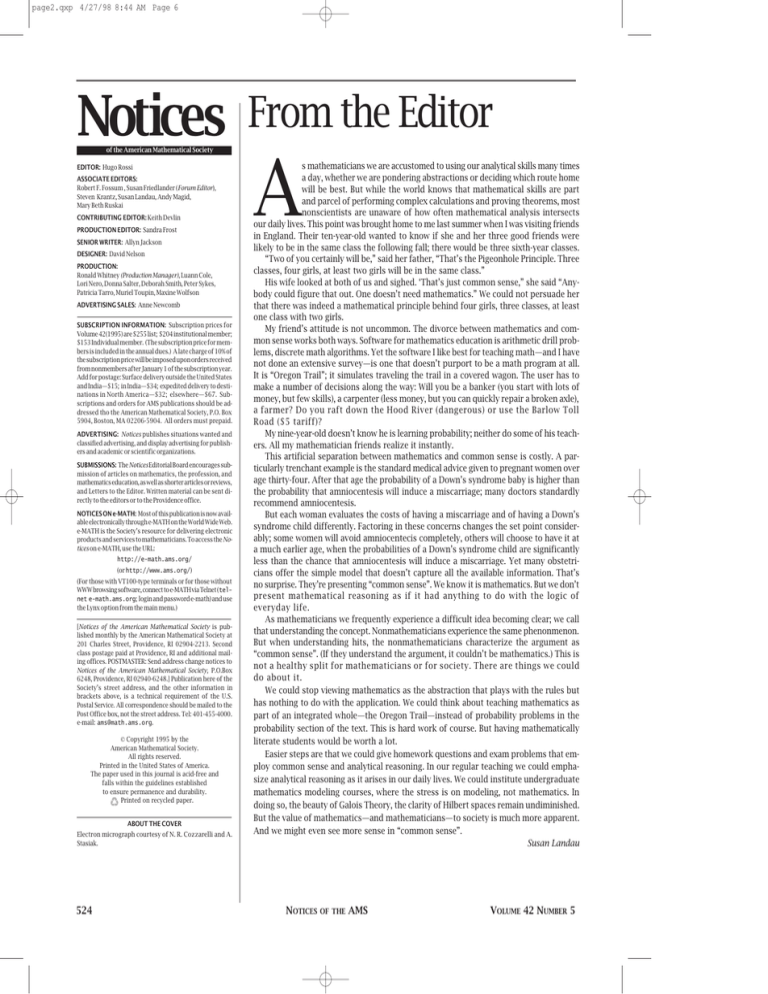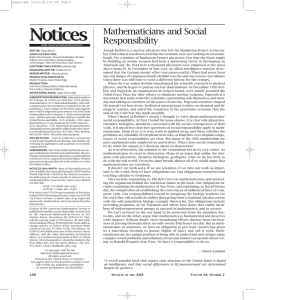
page2.qxp 4/27/98 8:44 AM Page 6
Notices
of the American Mathematical Society
EDITOR: Hugo Rossi
ASSOCIATE EDITORS:
Robert F. Fossum , Susan Friedlander (Forum Editor),
Steven Krantz, Susan Landau, Andy Magid,
Mary Beth Ruskai
CONTRIBUTING EDITOR: Keith Devlin
PRODUCTION EDITOR: Sandra Frost
SENIOR WRITER: Allyn Jackson
DESIGNER: David Nelson
PRODUCTION:
Ronald Whitney (Production Manager), Luann Cole,
Lori Nero, Donna Salter, Deborah Smith, Peter Sykes,
Patricia Tarro, Muriel Toupin, Maxine Wolfson
ADVERTISING SALES: Anne Newcomb
SUBSCRIPTION INFORMATION: Subscription prices for
Volume 42(1995) are $255 list; $204 institutional member;
$153 Individual member. (The subscription price for members is included in the annual dues.) A late charge of 10% of
the subscription price will be imposed upon orders received
from nonmembers after January 1 of the subscription year.
Add for postage: Surface delivery outside the United States
and India—$15; in India—$34; expedited delivery to destinations in North America—$32; elsewhere—$67. Subscriptions and orders for AMS publications should be addressed tho the American Mathematical Society, P.O. Box
5904, Boston, MA 02206-5904. All orders must prepaid.
ADVERTISING: Notices publishes situations wanted and
classified advertising, and display advertising for publishers and academic or scientific organizations.
SUBMISSIONS: The Notices Editorial Board encourages submission of articles on mathematics, the profession, and
mathematics education, as well as shorter articles or reviews,
and Letters to the Editor. Written material can be sent directly to the editors or to the Providence office.
NOTICES ON e-MATH: Most of this publication is now available electronically through e-MATH on the World Wide Web.
e-MATH is the Society’s resource for delivering electronic
products and services to mathematicians. To access the Notices on e-MATH, use the URL:
http://e-math.ams.org/
(or http://www.ams.org/)
(For those with VT100-type terminals or for those without
WWW browsing software, connect to e-MATH via Telnet (telnet e-math.ams.org; login and password e-math) and use
the Lynx option from the main menu.)
[Notices of the American Mathematical Society is published monthly by the American Mathematical Society at
201 Charles Street, Providence, RI 02904-2213. Second
class postage paid at Providence, RI and additional mailing offices. POSTMASTER: Send address change notices to
Notices of the American Mathematical Society, P.O.Box
6248, Providence, RI 02940-6248.] Publication here of the
Society’s street address, and the other information in
brackets above, is a technical requirement of the U.S.
Postal Service. All correspondence should be mailed to the
Post Office box, not the street address. Tel: 401-455-4000.
e-mail: ams@math.ams.org.
© Copyright 1995 by the
American Mathematical Society.
All rights reserved.
Printed in the United States of America.
The paper used in this journal is acid-free and
falls within the guidelines established
to ensure permanence and durability.
Printed on recycled paper.
?'@@@@@@@@@@@@6K
W2@@@@6K?V'@@@@@@@@@@@@@@@6K
?W&@@@@@@@6XN@@@@@@@@@@@@@@@@@@6X?
?7@@@@@@@@@)T@@@@@@@@@@@@@@@@@@@1?
J@@@@@@@@@@@@Y@@@@@@@@@@@@@@@@@@@L
7@@@@@@@@@@@@W@@@@@@@@@@@@@@@@@@@)X?
?J@@@@@@@@@@@@@@R'@@@@@@@@@@@@@@@@@@1?
W&@@@@@@@@@@@@@@LN@@@@@@@@@@@@@@@@@@@L
7@@@@@@@@@@@@@@@)T@@@@@@@@@@@@@@@@@@@1
?J@@@@@@@@@@@@@@@@@@Y@@@@@@@@@@@@@@@@@@@L?
W&@@@@@@@@@@@@@@@@@@?3@@@@@@@@@@@@@@@@@@1?
7@@@@@@@@@@@@@@@@@@@?N@@@@@@@@@@@@@@@@@@@L
?J@@@@@@@@@@@@@@@@@@@5e3@@@@@@@@@@@@@@@@@@)X??O@?
?7@@@@@@@@@@@@@@@@@@@HeV'@@@@@@@@@@@@@@@@@@)?2@@?
J@@@@@@@@@@@@@@@@@@@5?e?N@@@@@@@@@@@@@@@@@@@@@@5?
?W&@@@@@@@@@@@@@@@@@@@H?f3@@@@@@@@@@@@@@@@@@@@@H?
?7@@@@@@@@@@@@@@@@@@@5gN@@@@@@@@@@@@@@@@@@@@5
J@@@@@@@@@@@@@@@@@@@(Yg?3@@@@@@@@@@@@@@@@@@@H
7@@@@@@@@@@@@@@@@@@@H?g?V'@@@@@@@@@@@@@@@@@5?
@@@@@@@@@@@@@@@@@@@5heN@@@@@@@@@@@@@@@@@H?
?I'@@@@@@@@@@@@@@@@Hhe?3@@@@@@@@@@@@@@@5
V4@@@@@@@@@@@@@@5?he?N@@@@@@@@@@@@@@(Y
I4@@@@@@@@@@@(Y?he?J@@@@@@@@@@@@@@H?
I'@@@@@@@@@HhfO&@@@@@@@@@@@@@5
?V4@@@@@@@5?he?@@@@@@@@@@@@@@@@H
?I'@@@@(Y?he?@@@@@@@@@@@@@@@@?f?O2@@?
V4@@@H
?O2@@@@L
?W2@@@@@@@@@@@@@@?fI4@?
?O2@@@@@@)X?
?&@@@@@@@@@@@@@@@L
?W2@@@@@@@@@1?
I4@@@@@@@@@@@@@1
O&@@@@@@@@@@@L
W@@@@@@@@@@@@@L?
O2@@@@@@@@@@@@@1
?W&@@@@@@@@@@@@@)X
O2@@@@@@@@@@@@@@@@L?hg
?7@@@@@@@@@@@@@@@1
?@@@@@@@@@@@@@@@@@@@1?hg
J@@@@@@@@@@@@@@@@@L?
?N@@@@@@@@@@@@@@@@@@@Lhg
7@@@@@@@@@@@@@@@@@1?
3@@@@@@@@@@@@@@@@@@1hg
?J@@@@@@@@@@@@@@@@@@@L
N@@@@@@@@@@@@@@@@@@@L?hf
?7@@@@@@@@@@@@@@@@@@@1
?3@@@@@@@@@@@@@@@@@@1?hf
J@@@@@@@@@@@@@@@@@@@@@L?
?N@@@@@@@@@@@@@@@@@@@Lhf
7@@@@@@@@@@@@@@@@@@@@@1?
3@@@@@@@@@@@@@@@@@@1hf
?J@@@@@@@@@@@@@@@@@@(?4@@?
N@@@@@@@@@@@@@@@@@@@L?he
W&@@@@@@@@@@@@@@@@@@H??I@?
?3@@@@@@@@@@@@@@@@@@1?he
7@@@@@@@@@@@@@@@@@@5
?V'@@@@@@@@@@@@@@@@@@Lhe
@@@@@@@@@@@@@@@@@@@H
N@@@@@@@@@@@@@@@@@@1he
@@@@@@@@@@@@@@@@@@5?
?3@@@@@@@@@@@@@@@@@@he
@@@@@@@@@@@@@@@@@(Y?
?N@@@@@@@@@@@@@@@@@5he
3@@@@@@@@@@@@@@@@H
3@@@@@@@@@@@@@@@@Hhe
N@@@@@@@@@@@@@@@5?
N@@@@@@@@@@@@@@@5?he
?@@@@@@@@@@@@@@@H?
?@@?he?3@@@@@@@@@@@@@0Y?he
J@@?he?N@@@@@@@@@@@0M?hf
?3@@@@@@@@@@@@@5
?N@@@@@@@@@@@@@H
?W&@@?hf@@@@@@@@0M
@@@@@@@@@@@@@=
?7@@@?
@@@@@@@@@@@0R4@@@?
?@@@@@@@@@@@@@@@@@@@@@@@@@@@@@@?hf
?@@@@@@@@@@?W2@@@@@@@@@@@@@@@@@@@?f?W2@@@@@@@@@@@@@@@@@@@@@@@@@@@@@(?hf
?3@@@@@@@@@T&@@@@@@@@@@@@@@@@@@@@?f?7@@@@@@@@@@@@@@@@@@@@@@@@@@@@@(Y?hf
?N@@@@@@@@V@@@@@@@@@@@@@@@@@@@@@@?fJ@@@@@@@@@@@@@@@@@@@@@@@@@@@@@@Hhg
3@@@@@@@X@@@@@@@@@@@@@@@@@@@@@@?e?W&@@@@@@@@@@@@@@@@@@@@@@@@@@@@@5?hg
N@@@@@@V@@@@@@@@@@@@@@@@@@@@@@@?e?7@@@@@@@@@@@@@@@@@@@@@@@@@@@@@(Y?hg
?3@@@@@X@@@@@@@@@@@@@@@@@@@@@@@?eJ@@@@@@@@@@@@@@@@@@@@@@@@@@@@@@H
?N@@@(R@@@@@@@@@@@@@@@@@@@@@@@@?e7@@@@@@@@@@@@@@@@@@@@@@@@@@@@@5?
3@@H?@@@@@@@@@@@@@@@@@@@@@@@@?e@@@@@@@@@@@@@@@@@@@@@@@@@@@@@(Y?
V4@??@@@@@@@@@@@@@@@@@@@@@@@@?e3@@@@@@@@@@@@@@@@@@@@@@@@@@@@H
?@@@@@@@@@@@@@@@@@@@@@@@@?eV'@@@@@@@@@@@@@@@@@@@@@@@@@@5?
?@@@@@@@@@@@@@@@@@@@@@@@@?e?N@@@@@@@@@@@@@@@@@@@@@@@@@(Y?
?@@@@@@@@@@@@@@@@@@@@@@@@?f3@@@@@@@@@@@@@@@@@@@@@@@(Y
?@@@@@@@@@@@@@@@@@@@@@@@5?fN@@@@@@@@@@@@@@@@@@@@@@(Y?
?3@@@@@@@@@@@@@@@@@@@@@@H?f?3@@@@@@@@@@@@@@@@@@@@(Y
?V'@@@@@@@@@@@@@@@@@@@@@g?V'@@@@@@@@@@@@@@@@@@0Y?
V4@@@@@@@@@@@@@@@@@@@@hN@@@@@@@@@@@@@@0M?
?I4@@@@@@@@@h?3@@@?
?V'@@?
N@@?
?@@?
ABOUT THE COVER
Electron micrograph courtesy of N. R. Cozzarelli and A.
Stasiak.
524
From the Editor
A
s mathematicians we are accustomed to using our analytical skills many times
a day, whether we are pondering abstractions or deciding which route home
will be best. But while the world knows that mathematical skills are part
and parcel of performing complex calculations and proving theorems, most
nonscientists are unaware of how often mathematical analysis intersects
our daily lives. This point was brought home to me last summer when I was visiting friends
in England. Their ten-year-old wanted to know if she and her three good friends were
likely to be in the same class the following fall; there would be three sixth-year classes.
“Two of you certainly will be,” said her father, “That’s the Pigeonhole Principle. Three
classes, four girls, at least two girls will be in the same class.”
His wife looked at both of us and sighed. ‘That’s just common sense,” she said “Anybody could figure that out. One doesn’t need mathematics.” We could not persuade her
that there was indeed a mathematical principle behind four girls, three classes, at least
one class with two girls.
My friend’s attitude is not uncommon. The divorce between mathematics and common sense works both ways. Software for mathematics education is arithmetic drill problems, discrete math algorithms. Yet the software I like best for teaching math—and I have
not done an extensive survey—is one that doesn’t purport to be a math program at all.
It is “Oregon Trail”; it simulates traveling the trail in a covered wagon. The user has to
make a number of decisions along the way: Will you be a banker (you start with lots of
money, but few skills), a carpenter (less money, but you can quickly repair a broken axle),
a farmer? Do you raft down the Hood River (dangerous) or use the Barlow Toll
Road ($5 tariff)?
My nine-year-old doesn’t know he is learning probability; neither do some of his teachers. All my mathematician friends realize it instantly.
This artificial separation between mathematics and common sense is costly. A particularly trenchant example is the standard medical advice given to pregnant women over
age thirty-four. After that age the probability of a Down’s syndrome baby is higher than
the probability that amniocentesis will induce a miscarriage; many doctors standardly
recommend amniocentesis.
But each woman evaluates the costs of having a miscarriage and of having a Down’s
syndrome child differently. Factoring in these concerns changes the set point considerably; some women will avoid amniocentecis completely, others will choose to have it at
a much earlier age, when the probabilities of a Down’s syndrome child are significantly
less than the chance that amniocentesis will induce a miscarriage. Yet many obstetricians offer the simple model that doesn’t capture all the available information. That’s
no surprise. They’re presenting “common sense”. We know it is mathematics. But we don’t
present mathematical reasoning as if it had anything to do with the logic of
everyday life.
As mathematicians we frequently experience a difficult idea becoming clear; we call
that understanding the concept. Nonmathematicians experience the same phenonmenon.
But when understanding hits, the nonmathematicians characterize the argument as
“common sense”. (If they understand the argument, it couldn’t be mathematics.) This is
not a healthy split for mathematicians or for society. There are things we could
do about it.
We could stop viewing mathematics as the abstraction that plays with the rules but
has nothing to do with the application. We could think about teaching mathematics as
part of an integrated whole—the Oregon Trail—instead of probability problems in the
probability section of the text. This is hard work of course. But having mathematically
literate students would be worth a lot.
Easier steps are that we could give homework questions and exam problems that employ common sense and analytical reasoning. In our regular teaching we could emphasize analytical reasoning as it arises in our daily lives. We could institute undergraduate
mathematics modeling courses, where the stress is on modeling, not mathematics. In
doing so, the beauty of Galois Theory, the clarity of Hilbert spaces remain undiminished.
But the value of mathematics—and mathematicians—to society is much more apparent.
And we might even see more sense in “common sense”.
Susan Landau
NOTICES
OF THE
AMS
VOLUME 42 NUMBER 5









